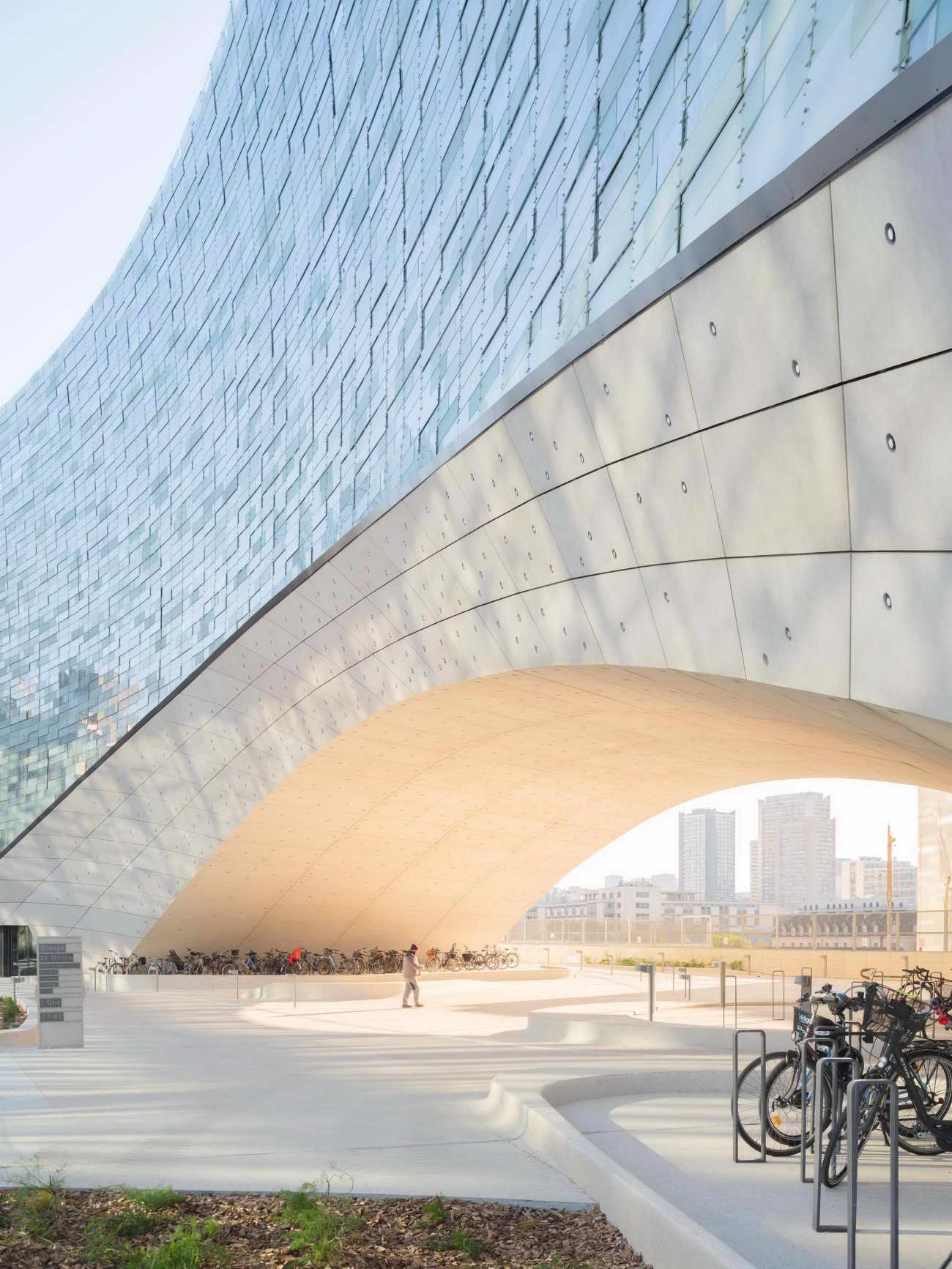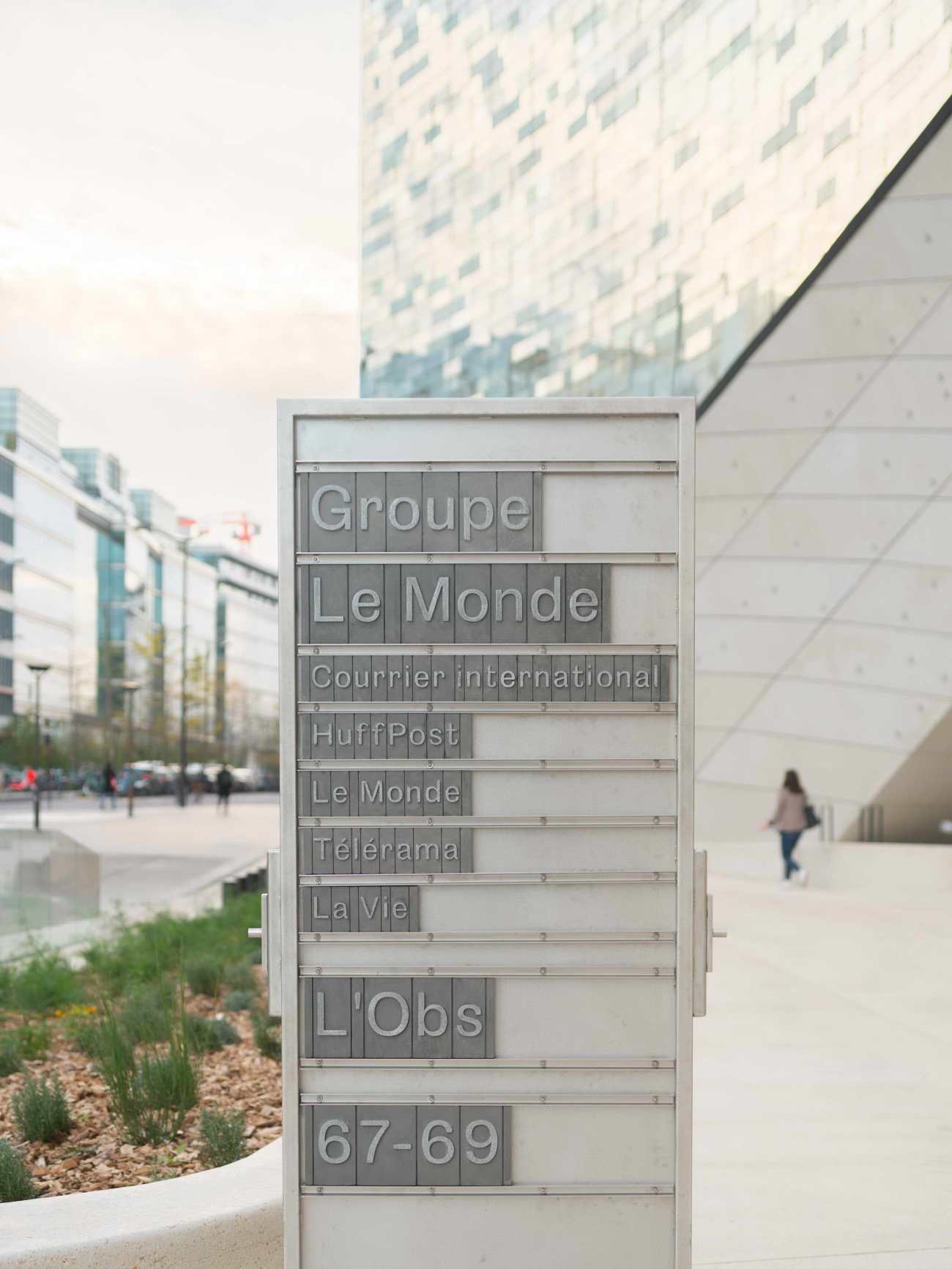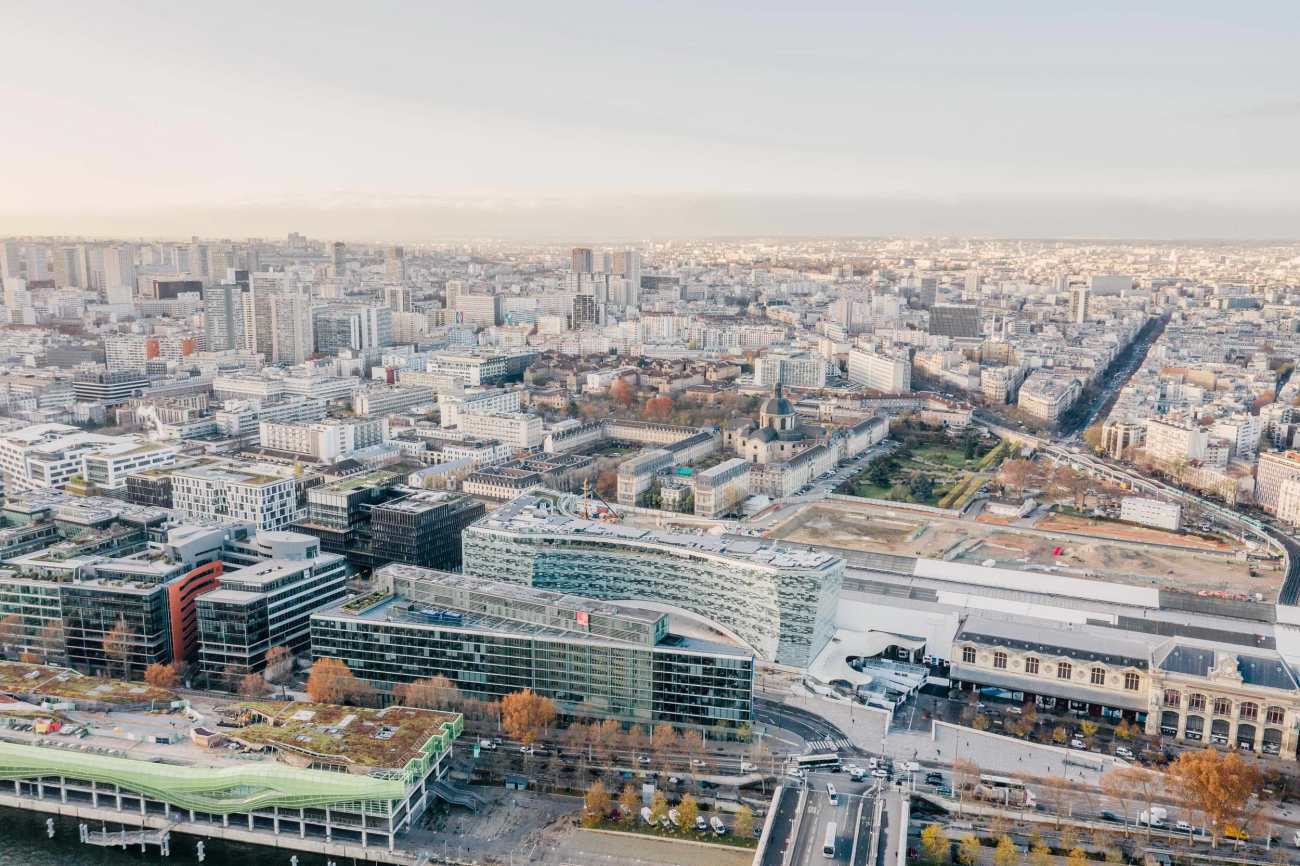该项目毗邻历史悠久的Gare d'Austerlitz火车站,与历史悠久的拉丁区和种植茂盛的植物园相邻。建筑物的凹形设计在地面下的货场上架起了桥梁,两边有两个七层楼高的悬臂体,由复杂的钢结构网络连接在一起。三个手势上的 "切口 "塑造了建筑体量:"天空切口 "揭示了太阳能板覆盖的屋顶的斜面;"城市切口 "将建筑从其面向街道的外立面向后拉开;"地面切口 "雕刻出桥梁结构的底部,将新的公共广场笼罩在其扩张的拱形形式之下。
Sitting adjacent to the historic Gare d’Austerlitz train station, the project is a close neighbor to the historic Latin Quarter and the lushly planted gardens of the Jardin des Plantes. The concave form of the building bridges over the below-grade railyard, anchored on both sides with two seven-story cantilevering volumes held together by a complex network of steel. Three gestural «cuts» shape the building mass: the «sky cut» reveals the oblique surface of the solar-panel-clad roof; the «city cut» pulls the building back from the along its street-facing facade; and the «ground cut» carves out the underside of the bridging structure, enveloping the new public plaza together beneath its expansive arched form.
一个现代的巴黎中心结构
23,000平方米的Le Monde集团总部建在法国首都历史悠久的老城区和高什河畔较现代化的地区的交汇处。该区以前是一个有铁轨的工业化地区,自20世纪90年代初以来,在18世纪奥斯曼化以来法国首都最全面的城市发展下,该区经历了大规模的发展。如今,该区已持续发展成为高密度的商业和商务区。
A Uniting Structure at the Heart of Modern-Day Paris
The 23,000 m2 Le Monde Group Headquarters is built at the intersection of the old, historic parts of the French capital, and the more modern districts on the Rive Gauche. A previously industrialized area with railway tracks, the district has experienced a mass development since the beginning of the 1990’s under one of the most comprehensive urban developments of the French capital since 18th century Haussmannization. Today, the district has continued to develop as a high-density commercial and business district.
建筑的像素化外皮由超过20000个像素化玻璃元素组成,以严格的组织模式,有772种可能的配置,使建筑的纯粹外观随天气和光线条件的变化而变化。每个玻璃元素代表一个独特的像素,根据其位置的不同,其不透明程度从透明到完全不透明不等,从而使建筑的最佳景观和最大限度的日光穿透力得以实现。这种高度复杂的图案参考了报纸和杂志上的印刷字母,构成了类似文字的图案,当从远处看到10000平方米的外墙时,可以更加清晰地阅读。
The building’s pixelated outer skin is composed of more than 20,000 pixelated glass elements in a strictly organized pattern with 772 possible configurations, that give the building a sheer appearance that shifts with the changing weather and light conditions. Each glass element represents one distinct pixel classified on an opacity scale ranging from transparent to fully opaque depending on its placement, allowing for the best views from the building as well as a maximum of daylight penetration. This highly sophisticated pattern references the printed letters of newspapers and magazines and makes up a text-like pattern that can be read more clearly when the 10 000 m2 facade is seen from afar.
该建筑从一侧到另一侧跨越80米,是对场地条件和挑战的回应。Le Monde集团于2014年收购了该地块,该地块位于奥斯特里茨火车站的铁路和月台之上,因此不可能建造一个技术性的地下室。因此,第一个挑战是建造一个建筑,将整个建筑的技术系统巧妙地融入到建筑本身的结构中。第二个挑战是,场地只能承受特定的重量,而且只能在场地的两个极端。由于中间部分并没有计划承载建筑的重量,客户最初的要求是在场地可建造的部分建造两座建筑。
Spanning 80 meters from one side to another, the building is a response to the conditions and challenges of the site: Acquired by the Le Monde Group in 2014, the site is situated just above the railways and platforms of the Gare d’Austerlitz which makes the creation of a technical basement impossible. The first challenge, therefore, was to construct a building where the entire technical system of the building would be cleverly incorporated into the structure of the building itself. The second challenge was that the site could only carry a specific amount of weight, and only on the two extremities of the site. As the middle section was not planned to hold the weight of a building, the client’s initial brief was to create two buildings on the parts of the site that were buildable.
 |  |
Snøhetta和SRA对这些挑战的回应是,通过一个钢结构的桥接结构将两个单元合并在一起,这对于一个比埃菲尔铁塔还重的建筑来说,是一个高要求的工程任务。然而,这是一项必要的任务:只有统一的建筑才能创造出一个充满活力的环境,将Le Monde Group集团旗下的不同杂志和报纸联合起来。
Snøhetta and SRA’s response to these challenges was to work on the idea of merging the two units together through a bridging structure of steel that would literally leapfrog from one side of the site to the other: a highly demanding engineering task for a building that weighs more than the Eiffel Tower. Nonetheless, it was a necessary one: only a unified building would create the dynamic environment needed to unite the different magazine and newspaper titles of the Le Monde Group.
一条穿越大楼的大道
Le Monde集团总部的旅程从地面开始,游客们会看到一个宽阔的公共广场,广场上有综合植物。广场邀请路人停留和互动,同时也与建筑两侧的城市景观建立了联系。从2021年起,随着一座新桥的引入,这种物理连接将得到进一步加强,该桥将横跨Gare d'Austerlitz的邻近铁路。
A Walk Through the Building
The journey through the Le Monde Group Headquarters commences at ground level where visitors are greeted by a broad public plaza with integrated vegetation. The plaza invites passersby to linger and interact while also creating connections to the cityscape on each side of the building. From 2021, this physical connection will be further enhanced with the introduction of a new bridge that will spanning across the neighboring railways of the Gare d’Austerlitz.
新的零售空间也有助于激活一个充满活力的公共领域。坐落在大楼温暖的拱门下,定制设计的混凝土长椅为繁忙的周边地区提供了避难所。该地块通过300多个自行车停车位和邻近的火车站,进一步鼓励多样化的交通模式和更环保的交通选择。
New retail spaces also help activate a dynamic public realm. Situated below the warmly lit arch of the building, custom designed concrete benches offer refuge from the activity of the busy surrounding area. The site further encourages diverse transit modes and greener mobility alternatives with more than 300 bicycle parking slots and through its immediate proximity to neighboring train station.
 |  |
The materiality of the plaza is predominated by concrete with clear references to the urban context of the building. The concrete environment creates a sense of continuity and consistency, as if parts of the ground were gently peeled back and fused into the arching roof soaring above the plaza. Cast in in-situ concrete, the arch above the plaza is carefully hand-treated to create a textured finish.
 |  |
混凝土广场和外立面的元素延续到建筑内部。建筑的路标也是由Snøhetta开发的,其灵感来自于建筑的玻璃外墙,并装饰有经典的打字机字体。这款定制的路标引导游客和员工轻松地穿过大楼。
The concrete plaza and elements from the façade continue inside the building. The building’s wayfinding, which is also developed by Snøhetta, is inspired by the glazed facade of the building and adorned with classic typewriter typography. This custom wayfinding guides visitors and staff effortlessly through the building.
Le Monde集团总部可以从建筑的两个边,其中一个公共入口,通往食品和零售服务,并提供一个两层楼的礼堂。另一个入口则通向建筑内只对Le Monde集团开放的部分接待区。接待区呈现出白色的画布,由灰色的混凝土水磨石地板框住,让人联想到外面的广场。
The Le Monde Group Headquarters can be accessed from the two extremities of the building, one of them public, leading to food and retail services and providing access to a two-story auditorium. The other entry leads to a reception area for parts of the building which are only accessible to the Le Monde Group. The reception area reveals itself as a white canvas framed by a grey-scaled concrete terrazzo flooring that evokes the plaza outside.
每个入口处都有两个大型露天剧场楼梯,通往建筑的第三层,为员工和访客提供了一个非正式的会议空间。楼梯与建筑的拱形中间部分形成了物理上的连续性,仿佛楼梯就安装在它的顶部。楼梯通过一个开放的接待区进入礼堂,非常适合举行会议或接待。该楼层还包括一个员工餐厅和餐厅,包括后台功能和会议室。
Two large amphitheater stairs in each entry lead up to the third level of the building, providing an unformal meeting space for staff and visitors. The stairs mark a physical continuity with the building’s arching middle-section, as if the stairs were mounted on top of it. The stairs provide access to the auditorium through an open reception area, well-suited for either conferences or receptions. The floor also comprises a staff cafeteria and restaurant including back office functions and meeting rooms.
 |  |
从3层到8层,大楼提供了高质量、宽阔的开放式办公空间,天花板上集成了供暖、通风和照明系统,确保大楼提供最大的布局灵活性。这些办公室拥有落地窗,可以俯瞰塞纳河和巴黎周边城市的景色,为《世界报》集团的数千名员工和记者提供了明亮宽敞的背景。二楼还设有图书馆、员工餐厅和Le Monde集团专用模拟档案馆等设施。
From the third to the eight floors, the building offers high-quality, expansive open office spaces with a ceiling-integrated heating, ventilation and lighting system assuring the building offers maximum layout flexibility. With its floor-to-ceiling windows, and views overlooking the Seine and the surrounding city of Paris, the offices offer a bright and spacious backdrop for the thousands of employees and journalists of the Le Monde Group. Floors second also feature amenities such as a library, a staff restaurant and an analogue archive dedicated to the Le Monde Group.
从五楼到六楼,是《世界报》新闻组专用的办公空间。就像下面的办公楼层一样,Le Monde办公室被组织成一个开放的空间,同时也提供了多种灵活的工作空间,整合了100多个私人工作区和40多个会议室,供团体合作使用。各楼层之间由一个双螺旋形楼梯连接,打开两层楼的中央部分。楼梯将新闻编辑室连接在一起,打破了人为的协作障碍,确保整个新闻编辑室的信息可以轻松共享。
From the fifth to the sixth floor, one finds the office spaces dedicated to the Le Monde newsgroup. Just like the office floors below, the Le Monde offices are organized as an open space, while also offering a diversity of flexible workspaces that integrate over 100 private work areas and over forty meeting rooms for group collaboration. The floors are connected by a double-spiraling staircase that opens the central part of the two levels. The staircase ties the newsroom together, breaking down artificial collaboration barriers and securing that information may be shared easily across the entire newsroom.
最后,建筑的顶层通向一个露天平台,从建筑的两侧都可以进入。在植被的衬托下,露台上的美景可以俯瞰周围的城市景观和塞纳河。
Finally, the top level of the building leads out to an open-air terrace which is accessible from both sides of the building. Framed by vegetation, the terrace creates beautiful views overlooking the surrounding cityscape and the Seine.
Project: Le Monde Group HQ
Design firm: Snøhetta
Building Completed: First half of 2020 (Started February 2017)
Competition: 2014 - January 2015
Building permit/Permis de Construire: January 2016
Location: 67 Avenue Pierre Mendès-France 75013 Paris, France
Certifications: BREEAM Excellent, Etiquette COV A+
Size: 22 933 m2 net (SDP)
Budget: Confidential
Client/Maître d’Ouvrage : Le Monde Group
Client/Assistant à Maître d’Ouvrage : Redman IDF
Photo credit: Frédéric Chaume, JARED CHULSKI, Ludwig Favre PAris, 2019Marwan Harmouche
更新日期:2020-12-17 16:25:05
非常感谢 Snøhetta 带来的精彩项目, 查阅更多Appreciations towards Snøhetta for sharing wonderful work on hhlloo. Click to see more works!



















